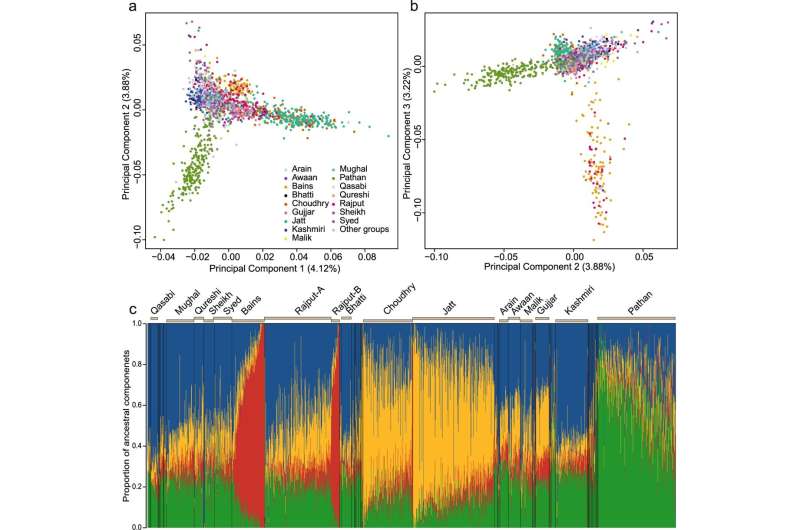Genetic history of British Pakistanis mapped for the first time

The first fine-scale analysis of genetic diversity within the British Pakistani population has been conducted by researchers at the Wellcome Sanger Institute, the University of Leeds, the Bradford Institute for Health Research (BIHR) and their collaborators. The research reveals that the genetic structure of this population has been shaped over a period of around 2,000 years by the biraderi social system, a practice of marrying within clans.
The study, published today (10 December 2021) in Nature Communications, details genetic differences between biraderi groups that will have important implications for the design of medical studies seeking to discover the genetic roots of common illnesses, such as diabetes and heart disease. These data will help to ensure that those of Pakistani ancestry are represented in such research, and will be able to benefit from new knowledge and therapies that emerge.
Human genomes are approximately 99.9 percent identical, regardless of ancestry. The remaining 0.1 percent holds differences between individuals, called genetic variants, which make us unique. Most genetic research to date has been conducted on European-ancestry individuals, which has led to a fuller understanding of human genetic variation, population structure and the role of genetic variation in disease.
However, findings about the genetic contribution to disease in Europeans may not translate well to individuals of other ethnicities. In recent years, studies of non-Europeans have started to provide a more complete picture of human genetic diversity and associated medical implications.
History and culture have influenced the genetic make-up of populations from different parts of the world. One such cultural factor is the biraderi social system, which has been practiced in Pakistani populations for centuries. Historically, people tended to marry within their own biraderi (community) to reinforce hereditary social status, occupation and land ownership. This system is still practiced to some extent today, both in Pakistan and within Pakistani-ancestry populations in countries like the UK.
In this study, researchers analyzed genomes from over 4,000 Pakistani-ancestry individuals, together with self-reported information about their family history, to investigate the genetic characteristics of the British Pakistani population. These data were collected by the Bradford Institute for Health Research (BIHR) as part of the Born in Bradford project.
Scientists at the Wellcome Sanger Institute and the University of Leeds analyzed the genomic data to map the fine-scale population structure and explore the demographic history of British Pakistanis.
Though Bradford Pakistani groups were found to be genetically similar to other Pakistani and Indian populations, the study found evidence that the biraderi social system has played an important role in shaping genetic variation. Participants shared the same genetic history until around 2,000 years ago, when they started separating into biraderi groups, including the Pathan, Jatt, Rajput, Awan, Gujjar, Mughal, Syed, Arain, Qasabi, and Bains.
Sanger's Dr. Elena Arciero conducted analysis that revealed that some groups experienced reductions in effective population size at various points in history. This could have been due to an increase in marriage-within-groups or an actual reduction in the population size as recorded in census data.
"Prior to this study our knowledge of the genetic history of these biraderis was quite sparse, so it adds considerably to our understanding of the social history of Pakistan. There is historical evidence to suggest that marriage within biraderi groups began to increase around 2000 years ago and became stricter during colonial times under the British Raj, when new property taxes were introduced to generate revenue. This may explain the reduction in effective population size that we observe in the genomic data," says Dr. Sufyan Dogra, senior research fellow from the Bradford Institute for Health Research (BIHR).
Previous research from Born in Bradford has shown that there is an increase in risk of recessive disorders amongst the children of first cousins, which is similar to that for children born to white British mothers aged 34 and over. This study finds that recessive disorders are likely to be more common amongst the children of couples who are not closely related but come from the same biraderi group, because their parents are distantly related. However the risk is at least 10 times higher for children of first cousins than for children of unrelated parents from the same biraderi.
"The study represents a step forward in the potential benefits of genetic research for marginalized populations, consistent with a wish to broaden the knowledge base and clinical benefits of genetic studies," Dr. Mark Iles,
a senior author of the study from the University of Leeds.
The findings have important medical implications for British Pakistanis. Incidence of common diseases like type-2 diabetes and heart disease are two-to-four times higher than in the white British population. The detailed genetic structure mapped in the study will help researchers to design future studies and search for common variants associated with these and other health problems, with the aim of improving diagnosis and treatment of these diseases as well as tailoring preventative advice.
"It is important to understand the fine-scale structure of a population when planning medical research such as genome-wide association studies. I hope our findings will provide a foundation for future research into the causes of genetic disease in Pakistani populations," Dr. Hilary Martin, a senior author of the study from the Wellcome Sanger Institute.
More information: Elena Arciero et al, Fine-scale population structure and demographic history of British Pakistanis, Nature Communications (2021). DOI: 10.1038/s41467-021-27394-2




















